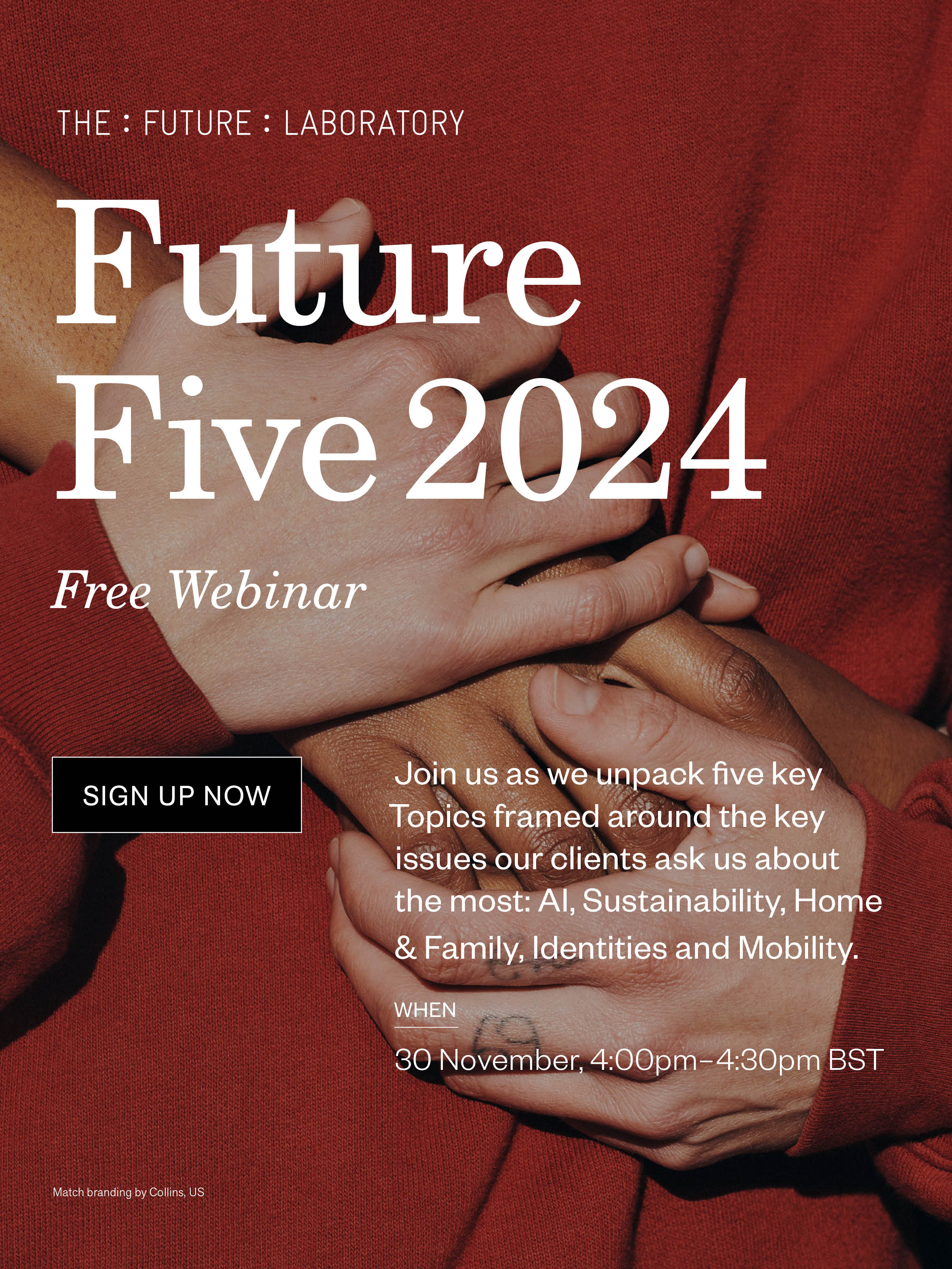27 : 10 : 23 : Weekly Debrief
This week: Dutch Design Week 2023, the future of automotive advertising, LVMH is training the craftspeople tomorrow, revealing teenagers' beauty spending habits, Gen Alpha and the alternative food market, Shanghai is labelling sugary drinks, and our upcoming Future Five.
27 October 2023
Author: The Future Laboratory
Image: MINI x Morgan Myerscough for London Design Festival, UK
Share
𝕏
1. Dutch Design Week 2023 Daily Recap: Envisioning Equilibrium Cities
The Netherlands - On day three of Dutch Design Week 2023, artists presented their forward-thinking visions for a planet that was more sustainable, equitable and livable.
Transnatural’s Radical City Inc exhibition challenged traditional urban concepts and introduced speculative cities that could withstand climate challenges while integrating nature into their design. Liquid Roots by Rollo Bryant proposed an innovative approach to street lighting that not only reduces artificial light pollution in urban environments but also creates a habitat for local flora and fauna. This project, scheduled for realisation in late 2023, aims to enhance safety for residents while preserving the local wildlife.
Elsewhere, various projects explored the loss of biodiversity in the urban environment and proposed solutions for the reintroduction of animals such as otters and birds. Otterdam is a floating allotment garden designed to support otters and inspired by similar floating gardens seen in Asia and South America. Theun Karelse explains how the reintroduction of otters can boost the local ecosystem: ‘If otters thrive here, it indicates a flourishing biome with healthy fish, aquatic plants, frogs and other interconnected creatures.’
Two noteworthy projects, Totems of Life from Radical City Inc and Omlab, a winner of the 2023 Dutch Design Awards, proposed habitat solutions for urban wildlife, including sparrows, swallows and starlings. While Totems of Life - a sculpture-like feature - serves as functional city decor, Omlab is more of a versatile, temporary solution for large-scale developments where nature management is just getting underway.
Conscious mobility futures were also on creatives’ minds this year. The Embassy of Mobility aims to make the transition from car dependency tangible and understandable. The show covered a wide range of topics, such as the increased demand for improved bicycle infrastructure as a result of the heightened interest during the pandemic and robotic transport as cities require more seamless and efficient systems.
Looking further ahead to the future of cars, Eindhoven University of Technology presented a concept for the world’s first off-road solar car and another vehicle designed to last a lifetime.
 Maison des Métiers d’Excellence LVMH. Photography by Hannah Lévesque, France
Maison des Métiers d’Excellence LVMH. Photography by Hannah Lévesque, France
2. The luxury sector is investing in training the craftspeople of tomorrow
Europe – In October 2023, luxury conglomerate LVMH unveiled plans to supercharge its training ecosystem, consisting of nearly 360 programmes worldwide ensuring the transmission of know-how in leather goods, fashion design and client advisory.
The group also announced the construction of the future Maison des Métiers d’Excellence in Paris, a venue that will be dedicated to showcasing LVMH’s savoir-faire to the public. From 2025, the 2,000-square-metre space will offer courses and workshops where working artisans will teach fashion techniques. It will also be home to a café, store and exhibition space, all themed around craftsmanship.
Elsewhere, Kering-owned luxury house Bottega Veneta is also committing to passing on its knowledge with the Accademia Labor et Ingenium (Academy of Craft and Creativity). The school will take on 50 students a year, guaranteeing employment upon completion of the programme led by five Bottega Veneta master artisans.
In our Luxury Recrafted macrotrend, we delve deeper into why it is crucial for the sector to invest in talent and safeguard the proprietary skills that are the beating heart of luxury.
3. Automotive Advertising Futures
Consumers' choice of car colour holds many insights into their psyche and overall optimism.
In the UK, the early years of Tony Blair’s government initiated a race to buy cars in bright primary colours. But as the economy soured, drivers went for sensible greys and silvers.
After the 2008 financial crisis, they went through a dark phase where black car sales predominated. According to The Economist, during David Cameron’s Tory-Lib Dem coalition government, white cars suddenly rose to the top spot, either because the economic mood was lightening or 'perhaps because draining a car of colour is another way of not making a firm choice'.
Following Theresa May’s government and worries about Brexit, consumers went back to black. Since 2018, grey has been the go-to colour for new cars sold, reaching a record high of 25.7% in 2022 (source: Society of Motor Manufacturers and Traders).
The same report states that 62.5% of all new cars sold in 2022 were painted in monochrome shades – grey, black or white. Blue (16%), red (8.5%) and silver (6.1%) follow in respectively fourth, fifth and sixth place. Green is the only vibrant hue with a drastic volume change between 2021 and 2022 (+74.2%), with electric vehicles accounting for a quarter of all new green cars sold.
‘Automotive colour trends are constantly evolving to reflect changing consumer preferences and technological advancements,' Murat Tarcan, founder and director of branding and creative agency Disomt and former creative director of Jaguar and Land Rover UK, tells LS:N Global. 'In recent years, we've seen a shift towards more environmentally friendly and sustainable colours.'
4. Shanghai introduced coloured health labels for sugary beverages
China - In August 2023, the Shanghai Health Commission introduced a pilot initiative labelling sugary drinks with a three-tiered ‘red, orange and green’ health label system.
Following a roll-out of the new labelling system in more than 150 sales locations in Shanghai the Commission is now seeking feedback from customers on the initiative until 31 October 2023.
The use of a traffic light system to grade nutritional value is nothing novel, but perhaps necessary in China where, according to the Chinese Centre for Disease Control and Prevention, 46,633 deaths related to high-sugar beverages were recorded in 2019. This number is almost double that of 1990, though China’s average daily sugar consumption per person remains lower than in the US.
Reducing sugar consumption has become the number one nutritional concern for health-conscious consumers in recent years. Innovators within the food and drink industry must look to High Tech Sugar alternatives to satiate consumer demand for sweet treats, without the health ramifications.
 Phygital Supermarket Worlds by Xin Liu, US
Phygital Supermarket Worlds by Xin Liu, US
 Kiddiwinks. Identity by Young Jerks and Wildish & Co., US
Kiddiwinks. Identity by Young Jerks and Wildish & Co., US
5. Gen Alpha & Alt Foods
Set to be the biggest, longest-living generation in history, more than 2.5m Gen Alphas are born around the world every week (source: McCrindle). By 2025, their estimated economic footprint will exceed £4.48 trillion ($5.46 trillion, €5.18 trillion) and this generational group will account for almost two billion people (source: McCrindle).
Born between 2010 and 2024, many define Gen Alpha by their tech-native nature, but the biggest influence on their eating habits inevitably comes from their Millennial parents. Millennials are more likely than Gen Z to describe their diet as vegan or vegetarian or regularly use plant-based products (source: YPulse).
As a result, Gen Alpha are growing up with alternative foods commonplace in their diets – early eating habits that will shape the future of food and drink across the globe.
Meanwhile, eco-anxiety is driving an increase in planet-positive diets and an improved understanding of nutrition is being passed down from Millennial parents, bringing considerations such as gut health and protein deficiencies to the fore.
6. Stat: e.l.f is US teenagers' favourite cosmetics brand
US - The semi-annual Taking Stock With Teens survey by investment banking and institutional securities firm Piper Sandler has revealed teenagers' beauty spending habits across the US.
Interviewing 9,193 teenagers in September 2023, the survey found that teen spending on the ‘core beauty wallet’ (cosmetics, skincare and fragrance) is up 23% year-on-year, averaging at £267 ($324, €306). This increase was predominantly driven by spending on makeup, which averaged £104 ($127, €120), surpassing skincare for the first time since 2020.
E.l.f retains its status as teenagers’ favourite cosmetics brand (29%), followed by Rare Beauty (13%), while CeraVe and The Ordinary rank top for skincare. Beauty buys at speciality retailers also hit an all-time high at 79%, while purchases from mass-market retailers, department stores or drugstores dropped to a new low of 11%.
Selling affordable yet aesthetic makeup with clean credentials and a strong social media presence (including more than 1m TikTok followers), it's little wonder that e.l.f cosmetics is so popular with teenagers. As explored in our How beauty is being refined for Generation Z report, brands must look good, and be good, to appeal to younger cosmetics consumers.
7. Free Webinar: Future Five 2024-2025
Join us for this free webinar, giving you a concise overview of LS:N Global’s latest trends update. Future Five 2024 is designed to help you jump straight to the key insights, opinions and future opportunities that you need to know about right now.
The report is built around the Topics section on LSNGlobal.com, which features industry-leading insight, foresight, trend forecasting and strategic analysis of the most important themes of tomorrow, relevant for today. These are: AI, Sustainability, Home & Family, Identities and Mobility.
In this free webinar, including a Q&A with our experts, we’ll discuss five of our leading Topics, based on the issues that brands, companies and collaborators ask us about the most, or in some instances, the things that we think they should be asking about.
The session will take place on 30 November from 2:00pm to 2:30pm BST.
Register to attend our free 30-minute live-stream for a concise introduction to our Future Five research for 2024.
We will also launch an accompanying Future Five 2024 report, which will be available to purchase on the day.

Want to read more?
Become a member today!
Sign up to one of our trends intelligence platform, LS:N Global and get unlimited access to a hive of insights - from microtrends and macro trends to market reports, daily news, research across eight industry sectors and much more.
Discover our memberships
Already a member? Click here to login
